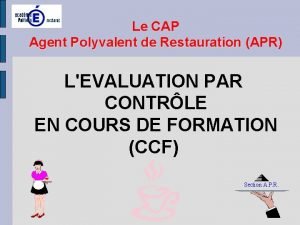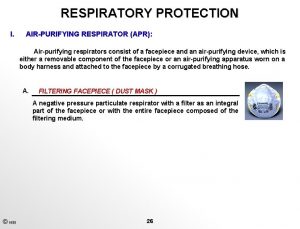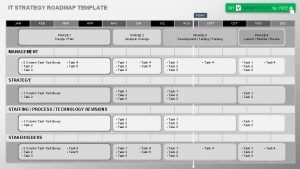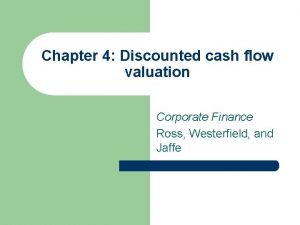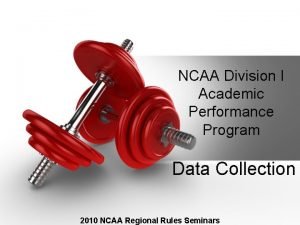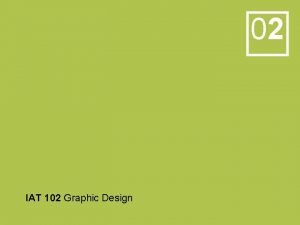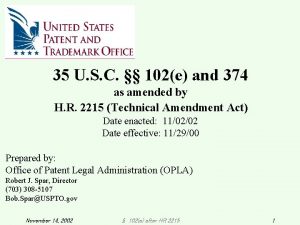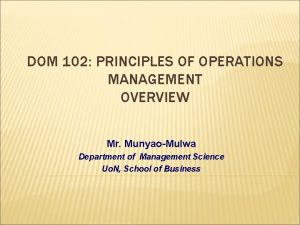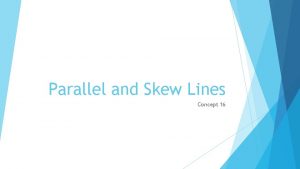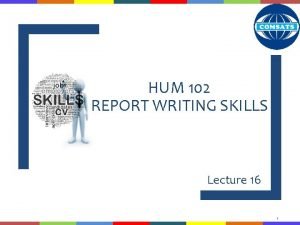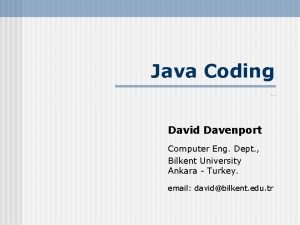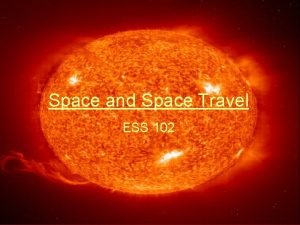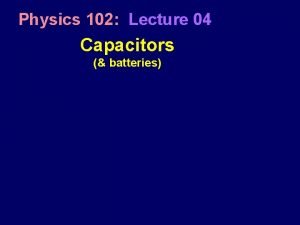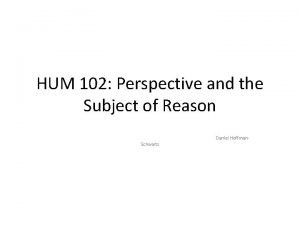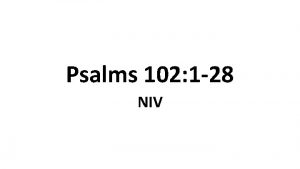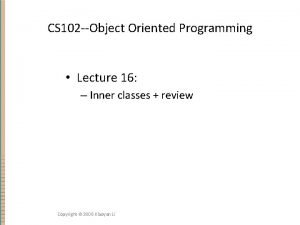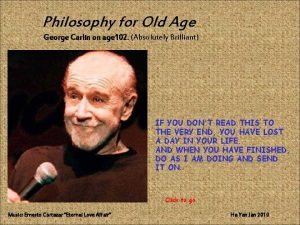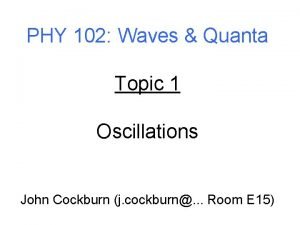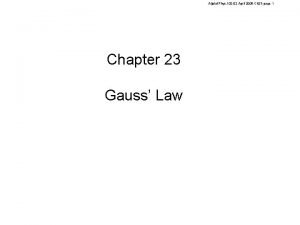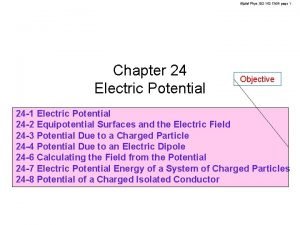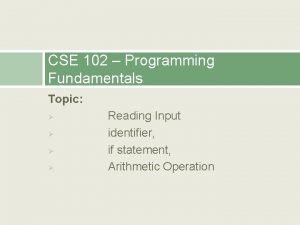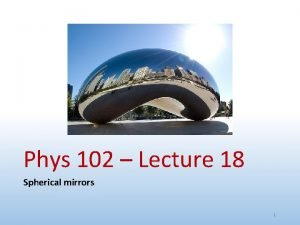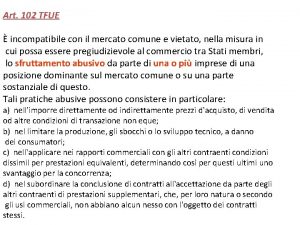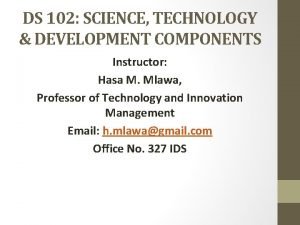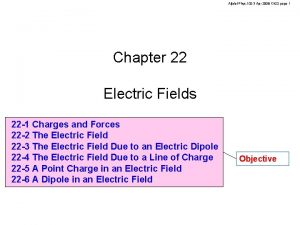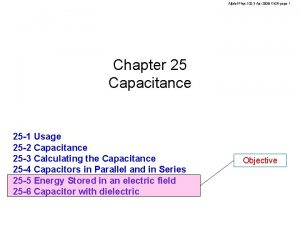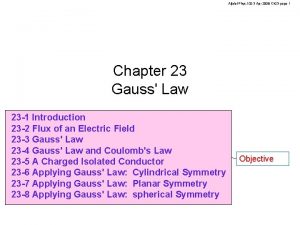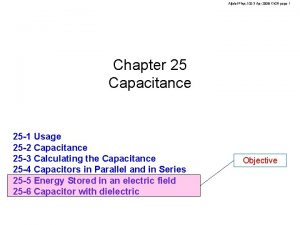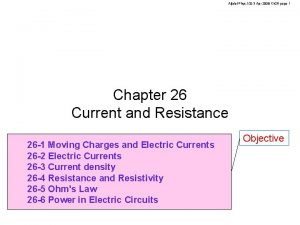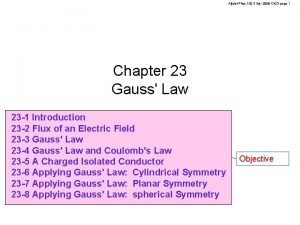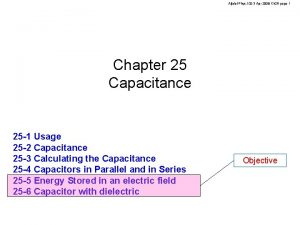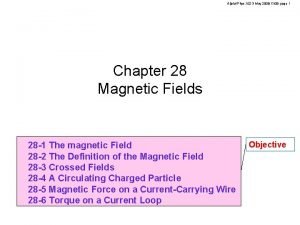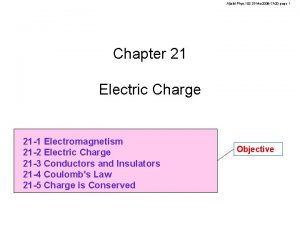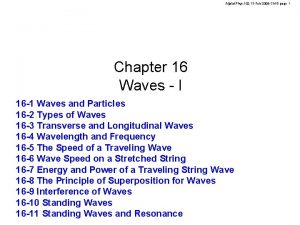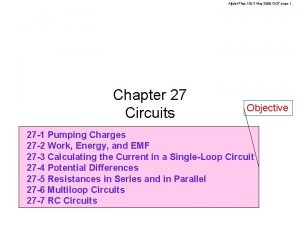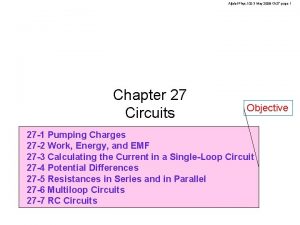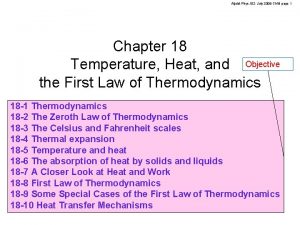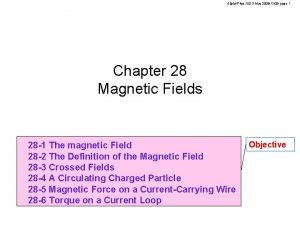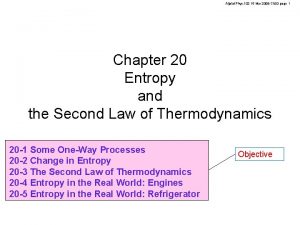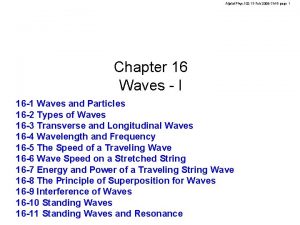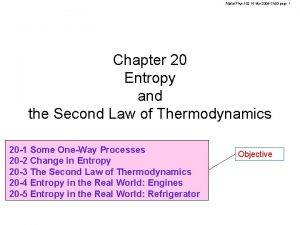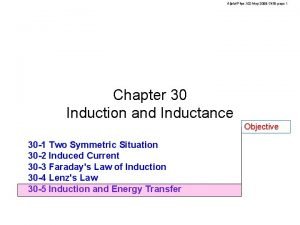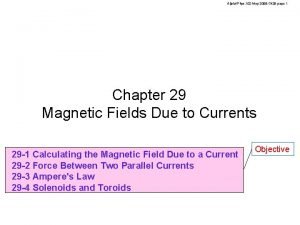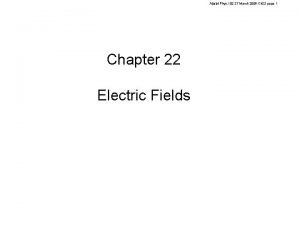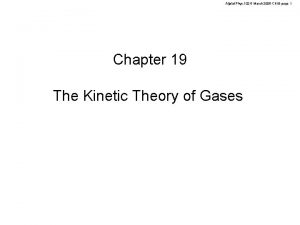AljalalPhys 102 3 Apr 2008 Ch 26 page




































- Slides: 36

Aljalal-Phys. 102 -3 Apr 2008 -Ch 26 -page 1 Chapter 26 Current and Resistance 26 -1 Moving Charges and Electric Currents 26 -2 Electric Currents 26 -3 Current density 26 -4 Resistance and Resistivity 26 -5 Ohm's Law 26 -6 Power in Electric Circuits Objective

26 -1 Moving Charges and Electric Currents Charges in motion Aljalal-Phys. 102 -3 Apr 2008 -Ch 26 -page 2 Electrostatics Charges do not move Electric current Charges move

Aljalal-Phys. 102 -3 Apr 2008 -Ch 26 -page 3 26 -1 Moving Charges and Electric Currents Electric current through a surface is the flow rate of net charges through the surface. 3 electrons moving towards us 3 electrons and 3 protons moving towards us +e -e -e -e Area A Current ≠ 0 -e +e -e -e +e Current = 0

Aljalal-Phys. 102 -3 Apr 2008 -Ch 26 -page 4 26 -1 Moving Charges and Electric Currents Random motion does not produce current Electric current through a surface is the flow rate of net charges through the surface. Cross section 4 electrons moving to the right -e -e Area A Current ≠ 0 Cross section 4 electrons moving randomly in all directions -e -e No net transport of charge Current = 0 Electrons in isolated conductor (no external electric field applied) Random motion - Speed ≈ 106 m/s

Aljalal-Phys. 102 -3 Apr 2008 -Ch 26 -page 5 26 -2 Electric Currents Formula - Electric current through a surface is the flow rate of net charges through the surface. Charge dq passes through surface A in time dt Wire Cross section Surface A Cross section

26 -2 Electric Currents Steady-state electric current Aljalal-Phys. 102 -3 Apr 2008 -Ch 26 -page 6 Total charge q passes through surface A in time t Surface A In a steady-state condition, current does not change with time.

26 -2 Electric Currents Electric current through a wire Wire Surface A 2 Surface A 1 Aljalal-Phys. 102 -3 Apr 2008 -Ch 26 -page 7 In a steady-state condition Current through A 1 = Current through A 2 = Current through A 3 Surface A 3 Since charge is conserved, any electron passes through A 1 should pass through A 2 and A 3.

Aljalal-Phys. 102 -3 Apr 2008 -Ch 26 -page 8 26 -2 Electric Currents SI unit for electric current SI unit for current Ampere Symbol A

Aljalal-Phys. 102 -3 Apr 2008 -Ch 26 -page 9 26 -2 Electric Currents Current is a scalar quantity We use arrows to indicate directions of currents in wires. i 1 i 3 i 2 i 1 = i 2 + i 3 These arrows are not vectors. i 1 = i 2 + i 3

Aljalal-Phys. 102 -3 Apr 2008 -Ch 26 -page 10 26 -2 Electric Currents Convention - current direction -e +e Current Moving free electrons Fixed electrons -e -e +e Conductor -e +e +e Conductor Fixed positive ions Charge carriers = electrons Moving positive ions Charge carriers = positive ions Real world Convention (agreement) Not real A current arrow is drawn in the direction in which positive charge would move, even if the actual charge carriers (electrons) are negative and move in the opposite direction.

Aljalal-Phys. 102 -3 Apr 2008 -Ch 26 -page 11 26 -2 Electric Currents Checkpoint 1 1 A 2 A Wire 2 A 2 A 3 A 4 A i? Solution Charge is conserved current in = current out Given current in = 3 + 2+ 4 + 2 = 11 A Given current out = 1 + 2 = 3 A i = 8 A out 8 A

Aljalal-Phys. 102 -3 Apr 2008 -Ch 26 -page 12 26 -2 Electric Currents Example 1 Water flows from a garden hose at a rate of 450 cm 3/s What is the current of negative charge? Garden hose Water flow rate of 450 cm 3/s Solution The current of negative charge = The current of positive charge There is no net flow of charge (current = 0) through the hose.

26 -2 Electric Currents Example 1 Solution Aljalal-Phys. 102 -3 Apr 2008 -Ch 26 -page 13

Aljalal-Phys. 102 -3 Apr 2008 -Ch 26 -page 14 26 -3 Current density Definition Point P Surface A 1 = 0. 2 m 2 Surface A 2 = 0. 4 m 2 4 coulombs pass per second through surface A 1 4 coulombs pass per second through surface A 2 Current through A 1= 4 A Current through A 2= 4 A

26 -3 Current density is a vector quantity Aljalal-Phys. 102 -3 Apr 2008 -Ch 26 -page 15 Current density is a vector quantity Direction The same direction as the velocity of the moving positive charges. Opposite to the direction of the velocity of the moving negative charges. Magnitude The SI unit for the current density J is A/m 2

26 -3 Current density Finding current from current density Aljalal-Phys. 102 -3 Apr 2008 -Ch 26 -page 16 Area vector Magnitude Area of the surface Normal to the surface Direction

26 -3 Current density Streamlines Aljalal-Phys. 102 -3 Apr 2008 -Ch 26 -page 17 Electric field lines Streamlines At any point, the tangent of an electric field line gives the direction of the electric field. At any point, the tangent of a streamline gives the direction of the current density. Number of lines per unit area in a plane perpendicular to the electric field lines is proportional to the magnitude of the electric field. Number of lines per unit area in a plane perpendicular to the streamlines is proportional to the magnitude of the current density.

Aljalal-Phys. 102 -3 Apr 2008 -Ch 26 -page 18 26 -3 Current density Illustration - Streamlines Same current Charge is conserved (Any charge passes though the 1 st surface should pass through the 2 nd surface Streamlines representing current density in the flow of charge through a conductor High current density Low current density

Aljalal-Phys. 102 -3 Apr 2008 -Ch 26 -page 19 26 -3 Current density Checkpoint 2 Electrons moving leftward -e -e -e Conductor What is the direction of … Solution Current? Rightward Current density? Rightward Electric Field? Rightward

Aljalal-Phys. 102 -3 Apr 2008 -Ch 26 -page 20 26 -3 Current density Example 2 R = 2. 0 mm J = 2. 0 X 105 A/m 2 Uniform current density R R/2 What is the current through the outer portion of the wire between radial distances R/2 and R? Cross section of a wire Solution

Aljalal-Phys. 102 -3 Apr 2008 -Ch 26 -page 21 26 -3 Current density Example 3 R = 2. 0 mm J = a r 2 a = 3. 0 X 1011 A/m 4 r in meters Not uniform current density d. A = 2 prdr R/2 R What is the current through the outer portion of the wire between radial distances R/2 and R? Cross section of a wire Solution

26 -4 Resistance and Resistivity Formula - Potential difference and current Resistor symbol V i An object (Resistor) V=Ri Potential difference Aljalal-Phys. 102 -3 Apr 2008 -Ch 26 -page 22 Current Resistance

Aljalal-Phys. 102 -3 Apr 2008 -Ch 26 -page 23 26 -4 Resistance and Resistivity SI unit for resistance Ohm Symbol W V=Ri W is pronounced omega

26 -4 Resistance and Resistivity Aljalal-Phys. 102 -3 Apr 2008 -Ch 26 -page 24 Resistance R of an object Resistivity r of a material Property of the object Property of the material Depends on the shape Does not depend on the shape SI unit ohm W SI unit ohm • meter W • m

Aljalal-Phys. 102 -3 Apr 2008 -Ch 26 -page 25 26 -4 Resistance and Resistivity Formula - Resistance and resistivity Calculating Resistance from Resistivity V i L A homogenous isotropic conductor of uniform cross section A and length L Area A homogenous property does not depend on the position Isotropic property does not depend on direction

Aljalal-Phys. 102 -3 Apr 2008 -Ch 26 -page 26 26 -4 Resistance and Resistivity Checkpoint 3 Solution V i 1 Area A L V i 2 1. 5 L Area A/2 V i 3 Area A/2 L/2 All made of copper Rank current greatest first.

26 -4 Resistance and Resistivity Formula - resistivity and temperature Aljalal-Phys. 102 -3 Apr 2008 -Ch 26 -page 27 Variation of resistivity with temperature Temperature coefficient of resistivity Reference temperature Resistivity at T 0 Temperature Good approximation over a wide temperature range

Aljalal-Phys. 102 -3 Apr 2008 -Ch 26 -page 28 26 -4 Resistance and Resistivity Example 3 For iron r = 9. 68 X 10 -8 W. m. What is the resistance of the block? V 1. 2 cm iron 15 cm 1. 2 cm V 1. 2 cm Solution

Aljalal-Phys. 102 -3 Apr 2008 -Ch 26 -page 29 26 -5 Ohm's Law Formula - Ohm's law V V i i V=Ri Constant Current is directly proportional to the potential difference Device obeys Ohm's law V=Ri Function of the potential difference Device does not obey Ohm's law

Aljalal-Phys. 102 -3 Apr 2008 -Ch 26 -page 30 26 -5 Ohm's Law Checkpoint 4 Which device does not obey Ohm's law? Device 1 V 1. 0 2. 0 3. 0 Device 2 I 2. 0 4. 0 6. 0 V 1. 0 2. 0 3. 0 I 1. 0 4. 0 9. 0 Solution Device 1 obeys Ohm's law Device 2 does not obey Ohm's law

Aljalal-Phys. 102 -3 Apr 2008 -Ch 26 -page 31 26 -6 Power in Electric Circuits Formula - Power i i B Device V i Power is the rate of electric energy transfer from the battery to the device. For any device (resistor, motor, capacitor) R B V i Power is the rate of electric energy transfer from the battery to the device. For a resistor V = R i

26 -6 Power in Electric Circuits Energy rate to rotate motors and charge capacitors i Aljalal-Phys. 102 -3 Apr 2008 -Ch 26 -page 32 i B motor V i Electric energy from the battery is transferred at a rate of P = i V to rotate the motor. B C V i Electric energy from the battery is transferred at a rate of P = i V to charge the capacitor.

26 -6 Power in Electric Circuits Energy rate to heat up resistors i R B V i Electric energy from the battery is transferred at a rate of P = i V to heat up the resistor. Aljalal-Phys. 102 -3 Apr 2008 -Ch 26 -page 33 When electrons drift through a resistor, they collide with the molecules of the resistor, this increases the random motion of the molecules which is equivalent to higher temperature.

26 -6 Power in Electric Circuits Derivation - Electric power Derivation of dq Aljalal-Phys. 102 -3 Apr 2008 -Ch 26 -page 34 The change in potential energy of dq is High electric potential = V The rate at which potential energy changes B Device V i loss Low electric potential = 0 Suppose a charge of dq moves through the device during time dt Since the energy is conserved, the rate at which potential energy is lost is the rate at which energy of other form is gained.

Aljalal-Phys. 102 -3 Apr 2008 -Ch 26 -page 35 26 -6 Power in Electric Circuits Checkpoint 5 i 0 Rank the change in the rate at which V 0 electrical energy is converted to thermal energy due to the resistance? 2 i 0 2 V 0 Solution R 0 R 0 i 0 V 0 2 R 0

Aljalal-Phys. 102 -3 Apr 2008 -Ch 26 -page 36 26 -6 Power in Electric Circuits Example 4 Nichrome heating wire Nickel-chromium-iron alloy R = 72 W V = 120 V At what rate is energy dissipated? Solution If the same voltage is applied to a wire that has half the original length, at what rate is energy dissipated ? Solution For half the length R = 36 W
 2008 2008
2008 2008 Nominal versus real returns
Nominal versus real returns Pqr gmp requirements
Pqr gmp requirements Cours cap apr
Cours cap apr What does apr stand for
What does apr stand for Apr air purifying respirator
Apr air purifying respirator Jan fab mar
Jan fab mar Apr vs ear
Apr vs ear àpr
àpr Apr vs ear
Apr vs ear Program
Program Sistem za centralizovano prijavljivanje korisnika apr
Sistem za centralizovano prijavljivanje korisnika apr What is a reference page in apa format
What is a reference page in apa format Emil ruder
Emil ruder 35 usc 102e
35 usc 102e Spacing in graphic design
Spacing in graphic design Dom 102
Dom 102 Bcd addition of 184 and 576
Bcd addition of 184 and 576 In the figure m 3=102
In the figure m 3=102 Hum 102
Hum 102 Csc102
Csc102 Eng 102 bilkent
Eng 102 bilkent Ess 102
Ess 102 Physics 102
Physics 102 Hum 102
Hum 102 Psalms 102 niv
Psalms 102 niv Cs 102 midterm
Cs 102 midterm Physics 102
Physics 102 Info 102
Info 102 Philosophy for old age (absolutely brilliant)
Philosophy for old age (absolutely brilliant) 102
102 102 cube
102 cube Aljalal phys 102
Aljalal phys 102 Cse102
Cse102 102
102 Art.102 tfue
Art.102 tfue Ds-102
Ds-102



